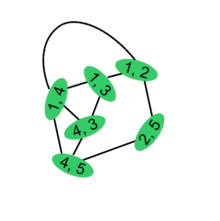Edge graph
The edge graph or line graph is a term from graph theory . He defines a new graph for a given graph, which is created by swapping nodes and edges.
definition
The edge graph or line graph of a simple graph is in graph theory the graph with the following properties:
- , that is, every edge of is a node in .
- , that is, two nodes from are in adjacent if the associated edges from have a common end node, i.e. are in adjacent.
example
The following example illustrates the construction of the edge graph for a given graph . The graph shown has the node set and the edge set .
A new graph is now constructed from the original , in that each edge of becomes a new node in (illustrated by the green ellipse on the original edges). The newly created nodes are connected to each other exactly when the edges collided in the original graph.
The result of the construction is obtained by hiding the original graph . The edge graph remains .
Expressed again as quantities one obtains .
properties
- The edge graph of the circle graph is isomorphic to its output graph . Circle graphs (or graphs of which all components are circle graphs) are the only graphs with this property.
- The edge graph of the star graph is the complete graph .
- The edge graph of a bipartite graph is a perfect graph .
- Every edge graph has a Krausz partition .
literature
- Lutz Volkmann: Foundations of the graph theory . Springer, Vienna / New York 1996, ISBN 3-211-82774-9 , pp. 180 ff .
Web links
- Lutz Volkmann: Graphs on all corners and edges . Script 2006, p. 146ff (PDF; 3.51 MB)


















